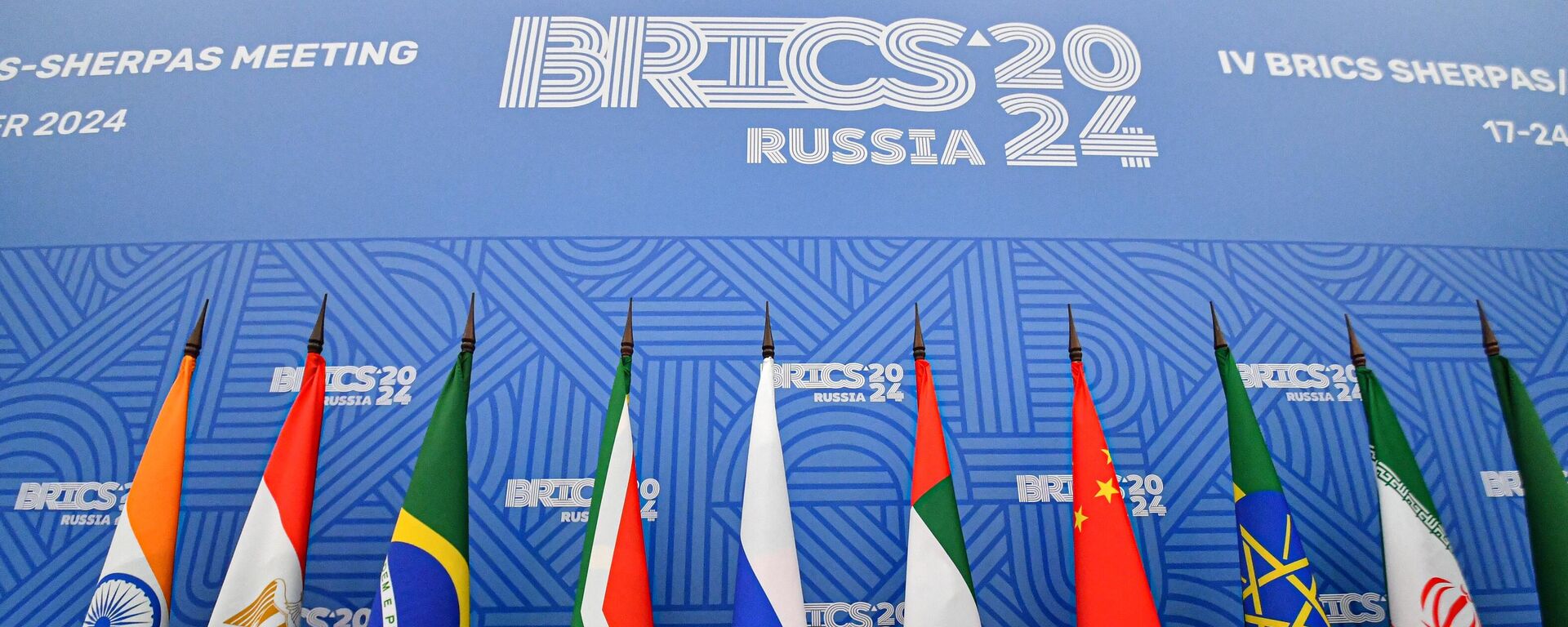https://en.sputniknews.africa/20241024/brics-economies-set-to-drive-global-growth-as-western-influence-wanes-imf-data-shows-1068851844.html
BRICS Economies Set to Drive Global Growth as Western Influence Wanes, IMF Data Shows
BRICS Economies Set to Drive Global Growth as Western Influence Wanes, IMF Data Shows
Sputnik Africa
According to estimates by Sputnik based on World Bank data, BRICS members represented 27.15% of the global economy in 2006, the year the organization was... 24.10.2024, Sputnik Africa
2024-10-24T13:09+0200
2024-10-24T13:09+0200
2024-10-24T18:40+0200
international monetary fund (imf)
global south
brics
west
g7
economy
economic growth
egypt
vietnam
germany
https://cdn1.img.sputniknews.africa/img/102299/54/1022995494_0:15:740:431_1920x0_80_0_0_52c615deb63330cd004e2417b70996fb.jpg
The global economy is becoming increasingly reliant on the BRICS group of emerging economies to drive growth, according to the latest forecasts from the International Monetary Fund (IMF).Countries like China, India, Brazil, and Russia are expected to account for a larger share of global expansion over the next five years as the contribution from advanced Western nations declines. The new predictions emphasized the growing role of emerging markets in shaping the future of the world economy.In its updated projections, the IMF has revised down the expected growth contributions from G7 economies, such as the US, Germany, and Japan, while increasing the share attributed to BRICS nations.China is forecasted to be the single largest driver of global growth through 2029, with its 22% share of global expansion surpassing the combined contribution of all G7 nations, according to Bloomberg calculations based on the IMF data. India, another BRICS powerhouse, is expected to add nearly 15% of total global growth, making it the second-largest contributor after China.Notably, some lower-income countries like Egypt and Vietnam are forecasted to contribute as much to global growth as advanced economies like Germany, Japan, and the UK. The projections also highlight that the G7’s smaller economies, such as Canada and Italy, will contribute less than 1% to global growth over the same period, underscoring the growing economic clout of populous, emerging nations.The IMF’s forecasts are based on purchasing power parity, a measure that adjusts for price differences across countries and tends to give more weight to economies with larger populations, such as China and India. This shift signals a potential rebalancing of global economic power as wealthier nations struggle to keep pace with the rapid expansion seen in the developing world.
https://en.sputniknews.africa/20241021/bricss-share-in-world-economy-has-grown-by-almost-10-since-its-foundation-analysis-1068792036.html
west
egypt
vietnam
germany
japan
asia
europe
united states (us)
north america
united kingdom (uk)
north africa
canada
italy
china
india
brazil
russia
south america
latin america
Sputnik Africa
feedback@sputniknews.com
+74956456601
MIA „Rossiya Segodnya“
2024
Christina Glazkova
https://cdn1.img.sputniknews.africa/img/07e7/0b/07/1063380906_0:0:673:674_100x100_80_0_0_79628b4d0cd9f29291a57aa13bbf9e7a.jpg
Christina Glazkova
https://cdn1.img.sputniknews.africa/img/07e7/0b/07/1063380906_0:0:673:674_100x100_80_0_0_79628b4d0cd9f29291a57aa13bbf9e7a.jpg
News
en_EN
Sputnik Africa
feedback@sputniknews.com
+74956456601
MIA „Rossiya Segodnya“
Sputnik Africa
feedback@sputniknews.com
+74956456601
MIA „Rossiya Segodnya“
Christina Glazkova
https://cdn1.img.sputniknews.africa/img/07e7/0b/07/1063380906_0:0:673:674_100x100_80_0_0_79628b4d0cd9f29291a57aa13bbf9e7a.jpg
international monetary fund (imf), global south, brics, west, g7, economy, economic growth, egypt, vietnam, germany, japan, asia, europe, united states (us), north america, united kingdom (uk), north africa, canada, italy, china, india, brazil, russia, south america, latin america
international monetary fund (imf), global south, brics, west, g7, economy, economic growth, egypt, vietnam, germany, japan, asia, europe, united states (us), north america, united kingdom (uk), north africa, canada, italy, china, india, brazil, russia, south america, latin america
BRICS Economies Set to Drive Global Growth as Western Influence Wanes, IMF Data Shows
13:09 24.10.2024 (Updated: 18:40 24.10.2024) Christina Glazkova
Writer / Editor
According to estimates by Sputnik based on World Bank data, BRICS members represented 27.15% of the global economy in 2006, the year the organization was founded. By 2023, this figure had risen to 36.8%. Meanwhile, the World Bank reported that the G7's share of the world economy declined from 36.7% in 2006 to 29% in 2023.
The global economy is becoming increasingly reliant on the
BRICS group of emerging economies to drive growth, according to the
latest forecasts from the International Monetary Fund (IMF).
Countries like China, India, Brazil, and Russia are expected to account for a larger share of global expansion over the next five years as the contribution from advanced Western nations declines. The new predictions emphasized the growing role of
emerging markets in shaping the future of the world economy.
In its updated projections, the IMF has revised down the expected growth contributions from G7 economies, such as the US, Germany, and Japan, while increasing the share attributed to BRICS nations.
China is forecasted to be the single largest driver of global growth through 2029, with its 22% share of global expansion surpassing the combined contribution of all G7 nations, according to Bloomberg calculations based on the IMF data. India, another BRICS powerhouse, is expected to add nearly 15% of total global growth, making it the second-largest contributor after China.
Notably, some lower-income countries like
Egypt and Vietnam are forecasted to contribute as much to global growth as advanced economies like Germany, Japan, and the UK. The projections also highlight that the G7’s smaller economies, such as Canada and Italy, will contribute less than 1% to global growth over the same period, underscoring the growing economic clout of populous, emerging nations.
The IMF’s forecasts are based on purchasing power parity, a measure that adjusts for price differences across countries and tends to give more weight to economies with larger populations, such as China and India. This shift signals a
potential rebalancing of global economic power as wealthier nations struggle to keep pace with the rapid expansion seen in the developing world.



